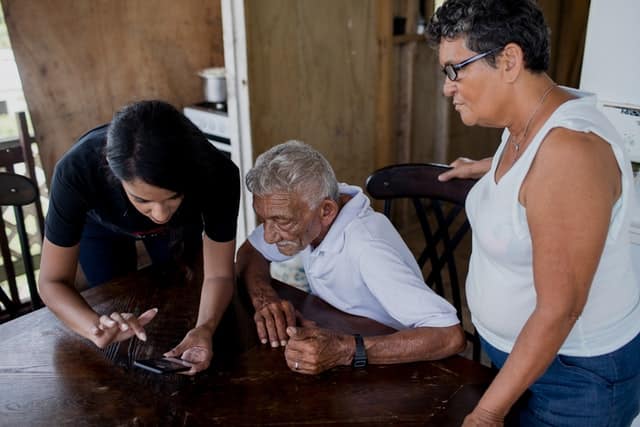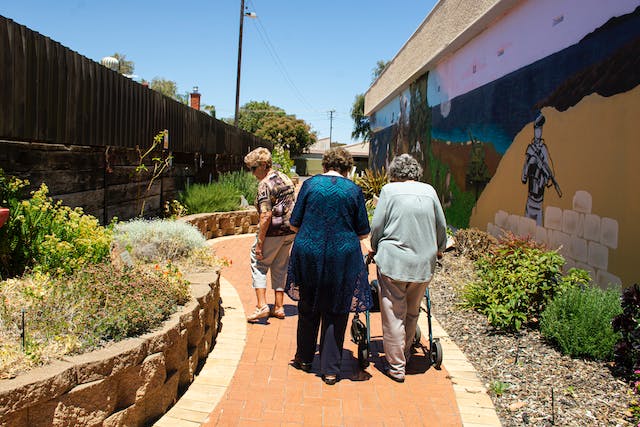Everybody grows old and sometimes ageing gracefully requires a little help. The Commonwealth Home Support Programme (CHSP) is an aged care service that assist in providing this to Australian seniors. It’s a little different from Home Care Packages, which are more consistent and/or cater for more intensive needs. But both provide you with at-home care.
Having supportive care or services at home instead of having to move into an aged care facility is important to many seniors. After all, home is where the heart is.
In this article, Blue Badge Insurance unpacks what CHSP is and how it works. We look at the eligibility criteria and the type of supports available and also how it compares to Home Care Packages.
In this article

What is the meaning of CHSP in Australia?
As mentioned, the CHSP is short for the Commonwealth Home Support Programme. It’s a government funded initiative that provides a broad range of basic supports to Australian seniors needing a bit (not a lot) of support to maintain a normal life at home.
This means seniors who want to and can continue to live comfortably and independently at home can, with a bit of assistance.
Unlike Home Care Packages for people needing more extensive support, the goal is providing a little assistance that keeps Australian seniors involved in the task instead of having someone take it over and do it for them completely.
Living with disability as an Australian senior
As many will know, Australian seniors aged 65 years and over can’t apply to the NDIS for the first time, whereas those who were NDIS participants before they turned 65 can continue to be so. Australian seniors also can’t benefit from the disability pension fund because of age criteria.
Find out more about these age limitations:
For those who pass the cut off date to benefit from NDIS funding, the alternative option is aged care support. My Aged Care options include Home Care Packages for those with disability and CHSP is the entry level to this for those who need a lower level of in-home assistance.

Why is CHSP important?
As mentioned, CHSP support helps Australian seniors continue living at home instead of relocating to an aged care facility. It can also assist caregivers in need of respite. So, the programme fills in some basic gaps that seniors and their caregivers need to stay healthy and active.
As part of the aged care programs, the CHSP and Home Care Packages can both provide home care. In contrast, residential aged care is for senior Australians whose care needs mean they can’t live at home anymore.
Home is where the heart is
Naturally, many Australian seniors prefer living at home as they grow older. Just because you can’t do certain tasks as easily as you used to doesn’t mean you want to lose your familiar habitat.
Most of us invest much time and effort into the place we call home and as such it provides that familiar comfort we wish to keep as we age.
Basic essential services to fill the gap
CHSP services are simple services and supports like a range of therapies, basic mobility aids and assistance with laundry and gardening. These services can help seniors who need mild support to stay independent and socially active.
If you’re a caregiver, CHSP services can also provide respite care so you get the break you need to revitalise.

Who is eligible for CHSP?
There are a range of eligibility criteria, including age, capacity and living circumstances.
Criteria
The CHSP is for Australian seniors who are 65 years and older, though if you identify as Aboriginal and Torres Strait Islander then you can access it at 50 years and over.
It’s also for anyone who’s prematurely aged and needs some additional support – here the age is 50 years + and 45 years + for Aboriginal and Torres Strait Islander Australians. Under this age bracket, one also needs to be experiencing certain stress factors. These include housing challenges (such as risk of becoming homeless) and a range of behaviours such as hoarding, for example.
Assessment
Finally, you also need to complete an assessment. You can book one online and someone comes to your home to do the assessment to check whether you’re eligible for services.
You can do the eligibility checker yourself beforehand to see whether it’s worth booking an assessment.

What services does CHSP include?
This program offers a variety of services from gardening to home modifications. Sometimes CHSP services can also be included in Home Care Packages.
Take a look at the full list of CHSP services:
1. Meals / food prep
This service helps to ensure you eat well. It’s about providing assistance with meal preparation, including special diets, and it offers meal delivery services (excluding food costs). It’s simple, efficient and focused on your nutritional needs.
2. Personal hygiene / grooming
Assistance here includes helping you with bathing, showering, toileting, dressing/undressing, getting in and out of bed and washing and drying your hair or shaving. It can also include gentle reminders to ensure you take your medication.

3. Therapies
Podiatry, physiotherapy and other therapies are geared towards assisting individuals in maintaining movement and mobility. This comprehensive approach includes speech therapy, podiatry, occupational therapy or physiotherapy services. It also includes clinical services like hearing and vision services.
4. Impairment / incontinence support
Assistance with impairments or continence issues help you manage specific health conditions, supporting your independence at home. This includes access to continence advisory services, dementia advisory services and vision and hearing services.
5. Respite care
Day and overnight respite services are designed to provide senior Australians and their carer with a well-deserved break. You can choose from centre-based respite (to socialise and engage with others, such as a day centre or club) or a residential setting. This can be during the day or overnight.
Alternatively, CHSP offers flexible respite where a paid carer comes to your home, giving the existing carer a short break.

6. Home modifications
This CHSP service is all about enhancing or maintaining senior Australians’ capacity to move around safely and independently at home. So this service is about providing practical modifications – like installing easy access taps, grab rails in the toilet, bath or shower, and ramps for easier mobility.
It also provides advice on safety concerns at home and can assist with accessing technical support for significant home modifications that aren’t covered by aged care services.
7. Home and garden maintenance
This is a service that ensures your home and garden remain safe and well-kept. Assistance ranges from fixing uneven flooring to cleaning gutters and handling basic garden maintenance tasks like weeding, pruning and mowing the lawn.
8. CHSP home chores
Everyone needs fresh laundry but as we age this can sometimes be a tricky task. Washing can be heavy and washing lines can be too high, for instance. This service supports senior Australians with a range of basic chores like laundry, vacuuming, mopping, ironing, making beds and more.

9. CHSP aids to stay independent
Sometimes a basic aid can make it possible to keep reading and communicating well. Sometimes it can make manoeuvring around the home much easier.
This CHSP service is about providing those aids, whether that’s an accessible mobile phone, screen reader for the computer, walking stick or a mechanical device for lifting. It could also be bed rails and pressure-relieving mattresses so you can get into bed more easily and get a good night’s sleep.
10. CHSP transport
Transport services are geared towards getting you out and about, covering everything from arranging a driver service to providing transport vouchers and subsidies (side note: do you know about taxi subsidies for wheelchair and mobility scooter users?).
This Commonwealth Home Support Programme assistance can be used for shopping, visiting health practitioners, or heading to social activities.
11. Social outings, groups and visitors
Social outings, groups and visitors services are all about keeping you connected and active in your community. A CHSP service can arrange for friendly visitors to make in-home or telephone-based social calls, provide companions to assist with shopping or appointments, and even coordinate transport to social events.
You can join group-based activities at a centre or receive assistance in setting up phone and internet communication services to stay connected with loved ones. Plus, if your carer is away, a care worker can visit you at home for a short period.

When did CHSP start?
The Commonwealth Home Support Programme was launched in 2015 to replace and consolidate a range of existing programmes. It replaced the:
- Commonwealth Home and Community Care (HACC) Program
- National Respite for Carers Program (NRCP)
- Day Therapy Centres (DTC) Program
- Assistance with Care and Housing for the Aged (ACHA) Program
Rolling these into the CHSP can make the process of applying for supports more streamlined. It also means senior Australians can find information for each of these types of services under the one umbrella.
Senior Australians living with disability deserve support
Many senior Australians require the support of the Commonwealth Home Support Programme, whereas some require more intensive disability support like Home Care Packages. Many who were already with the NDIS before the cut off age continue to receive disability supports.
Whichever bucket you fall into, if you have a disability parking permit, you’re able to get a range of disability discounts with Blue Badge Insurance. Learn about getting up to 25% off our disability car insurance and wheelchair accessible vehicles and disability converted cars. We also insure valuable mobility equipment with wheelchair insurance and mobility scooter insurance.
If your car or mobility aids are accidentally damaged or even stolen, then your insurance helps to pay for the repair or replacement. Click below to get a quote and we’ll get in touch with you.








